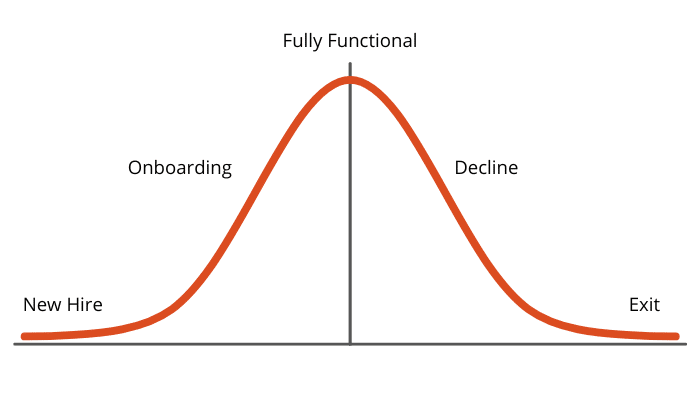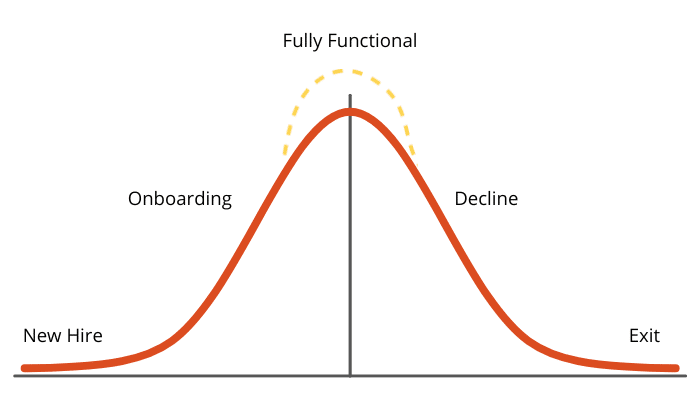Developing Employees Along their Growth Curve
As a manager, I’m in charge of a variety of departmental responsibilities. Given my role, these can include anything from financial oversight to compliance to human resources and more. The specifics vary from day to day, and while the scope of my work may not align perfectly with the issues you’re facing, one critical thing we have in common is this: we manage people, and we’re charged with getting the most out of them while at work.
There are endless theories and approaches to take when it comes to getting the best work from your teams, but one of the most effective ways I’ve found by utilizing our years of expertise in the area is to evaluate where employees are along their personal development curve and determine how I can have a positive impact on their position to help them move toward the fully functional area of the curve.
When I consider the development curve for an employee, it looks like this:

A new hire who joins your company, no matter what their previous experience or familiarity with your company, starts at the bottom of their curve. They have to make their way through the onboarding phase when they learn the specifics of their new role, get acquainted with the organizational culture, and develop or nurture the skills necessary to be successful within their role and team, as well as within the company at large. During onboarding they become more and more competent and better at their job and at navigating the culture until they reach the fully functional level of their role as defined by you, their manager.
If that employee falls out of that fully functional range, and things are not corrected quickly, they begin to decline and will likely eventually leave, either by their choice or yours. One of the most important things to understand about the curve, though, is that it’s individual. There is no standard timeline that it follows, and understanding what each phase means for you, your company, and your employee is important.
The Ideal Spot on their Growth Curve
I make a point to ask all of my employees where they believe their ideal spot is on the curve when I introduce this concept to them. My goal is to create transparency in what I want to accomplish as their manager. We discuss what it means to be in the “fully functional” range as it relates to their specific role, and what success looks like for them.
These conversations never look the same for two employees, and that’s a good thing. I’ve talked about presenting data with one person, and then with someone else I’ve focused on financial reporting. Or, you may also find yourself getting into knowledge-based items. For example, I’ve discussed the importance of knowing the particulars of the most recent Department of Labor or ERISA rule changes with employees in the past.
After having these conversations, the two answers I get the most about the ideal spot are “at the peak” and “just before the peak.” From my perspective, the ideal location is just before the peak. After all, once you hit the peak, the only place to go is down, and I want to avoid decline for any of my employees. I would rather continue the upward momentum they have at this point and not have to restart it if they reach the peak.
Sustaining the Pre-Peak Point
To keep an employee from peaking and stagnating, it’s my responsibility to adjust the curve with the employee as they develop. The timing is always important. Too early and the curve becomes too steep to climb, too late and the employee may already be well on their way to declining at an unstoppable trajectory.

By utilizing an adjustable version of this model, we create space to develop new expectations with the employee and push them higher than they thought they could go when they started with the company. This way, neither manager nor employee becomes complacent in their development (complacency is so often the precursor to stagnation, which leads to decline). With a continually evolving curve, an employee has the space in which to develop continually, ad infinitum.
A CEO I used to work for did this with me and it can be uncomfortable for the employee, especially for those driven to reach a specific accomplishment or to be “the best”. To some, reaching the apex is the goal. For me, continually having them develop is the goal. For this reason, it is important to have a dialogue around understanding the process, and not viewing the goal as unobtainable, but rather as a continual exercise in challenging oneself to be better.
Committed to Constant Improvement
As managers, we often have more on our to-do list than time in the day to accomplish it. The one thing we can never neglect, though, is our responsibility to our employees and our commitment to their success. Thinking this way not only helps my employees succeed, it also forces me to not accept it when they are falling short. If I see an employee not operating within the “fully functional” range, I know I need to push and encourage them to develop more, find more success, and continue that cycle of self-improvement.





